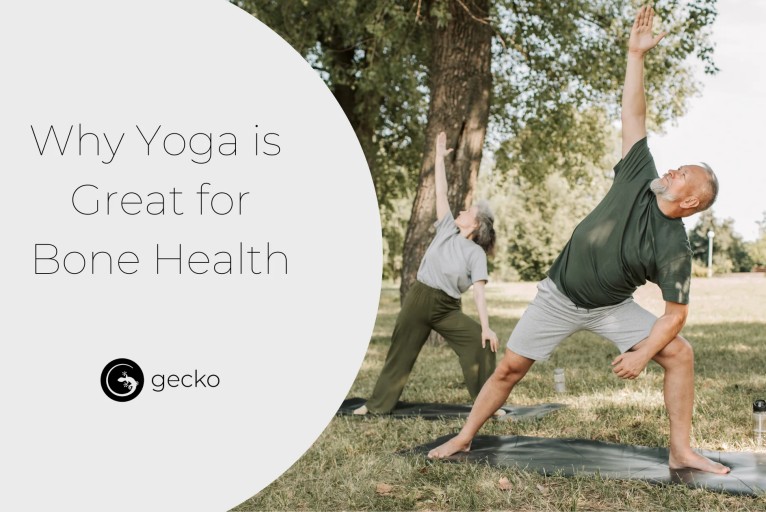Yoga for Bone Health: Strengthen Your Bones, Strengthen Your Life

For those who are living with osteoporosis, or simply want to take better care of your bone health, yoga can be life-changing.
Yoga asana - or physical yoga poses - are celebrated for calming the mind and developing lean muscle, but did you know that they can also help improve bone density?
In this article, we'll explore why yoga is one of the best tools for strengthening bones, and how to incorporate yoga into your bone health routine.
Understanding the Basics of Bone Health
Bones are living tissue-dynamic, constantly changing, and responsive to the demands placed on them.
As we age, our bone density naturally decreases, and for some, this leads to osteoporosis, a condition that makes bones brittle and more prone to fractures.
But change is a natural part of the lifespan of our skeleton. Bone remodeling is the process of replacing old bone tissue with new throughout life. In fact, the majority of the adult skeleton is replaced about every 10 years.
Bones respond to weight-bearing activity, meaning the right kind of movement can help strengthen them.
And, as bone tissue can become weaker, it can also become stronger. There are ways that we can improve our bone density to avoid the onset of osteoporosis, and potentially even reverse its effects.
That's where yoga comes in.
How Yoga Supports Bone Health
Bones respond to weight-bearing activity, meaning the right kind of movement can help strengthen them. Here are a few examples of why yoga is a must for anyone looking to improve their bone health.
Yoga Provides Weight-Bearing Without Impact
Unlike high impact forms of exercise like running, HIIT, or sports that can actually damage bone health, yoga is gentle on the joints yet effective at building strength. Many yoga postures are weight-bearing: think Chair Pose, Downward Dog, Warrior postures, Plank. These types of postures gently stress the bones, thus stimulating bone growth.
Yoga Improves Balance and Stability
A major concern for individuals with osteoporosis is the risk of falling. By enhancing proprioception - your body's sense of spatial awareness - yoga improves balance and coordination, helping to prevent falls. For instance, Tree Pose or Warrior III challenges balance muscles while concurrently engaging core and leg strength.
Yoga Emphasizes Correct Posture and Alignment
Joseph Pilates said, 'You are only as young as your spine is flexible.' Rounding of the spine is very common in osteoporosis, increasing the chance of fracture. Yoga strengthens postural muscles to support correct alignment, reducing stress on fragile areas such as the spine. Mountain Pose or Cat-Cow, while simple, can work wonders for spinal support.
Yoga Reduces Stress Hormones
Chronic stress and high cortisol levels can weaken bones. Yoga's emphasis on mindfulness and relaxation lowers stress levels, supporting overall hormonal balance - a key player in bone density regulation.
Yoga is Accessible for Everyone
Yoga is a highly accessible form of physical exercise because the poses can be adapted to the needs of any individual, regardless of age, physical ability, or injury. It also requires very little equipment or investment to get started - all you need is a yoga mat and an open mind!
Tips for a Safe Yoga Practice for Bone Health
Alignment is Key
Proper form is everything. Repeated misalignment in yoga can actually do more damage than good, so be sure you are building your poses in a safe and sustainable way. To start, practice in the presence of a teacher instead of taking online classes so they can offer corrections and guidance as you learn the proper structure of a pose. Props such as blocks, straps, or even a chair can be incredibly helpful for achieving correct alignment.
Focus on Length
Twists and forward folds are common in yoga, but an elongated spine is critical to avoid injury. Focus on creating space between the vertebrae and keeping a straight, flat back to keep pressure off the spine.
Start with Low-Impact Poses
Yoga is a journey. Start with simple, low-impact poses and begin adding new postures once you've developed the strength and body awareness to support them safely and sustainably. It is not about reaching the 'perfect' pose; it is about mindful movement and consistency. Be patient, and be kind to yourself.
Find a Teacher You Can Trust
A good yoga teacher should make you feel supported and empowered on your journey. Find a teacher you can trust, and who can work with you to design a practice that addresses your specific needs. However, be mindful that a yoga teacher is not an osteopath or physiotherapist, so they will have limitations.
Caring for Your Bones, One Pose at a Time
Whether you're living with osteoporosis or just looking out for your bone health, yoga offers a holistic, gentle, empowering road to stronger bones and, more importantly, a stronger you. So roll out your mat, breathe deeply, and know each pose is an opportunity for greater resiliency. Your bones will thank you!


